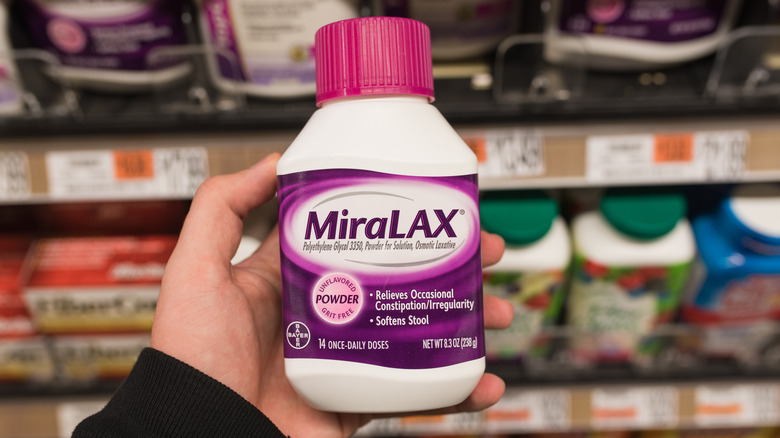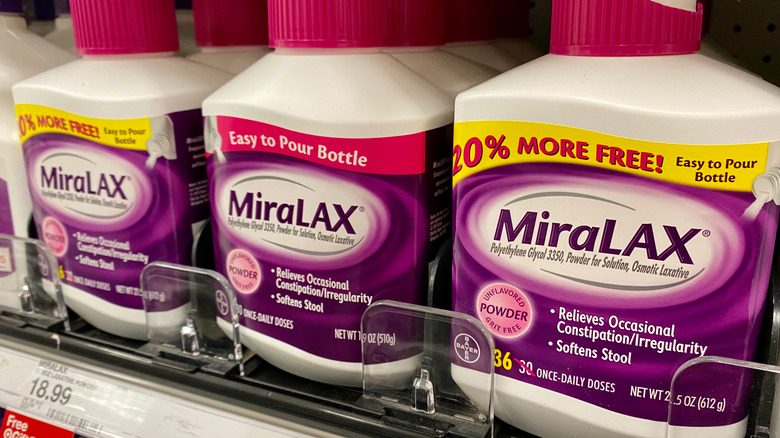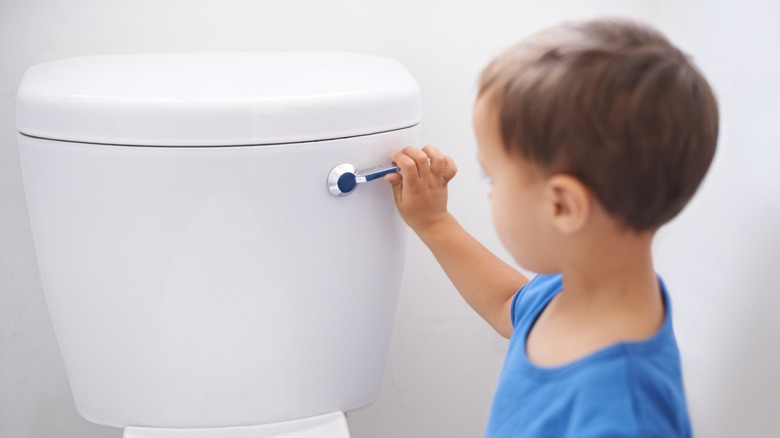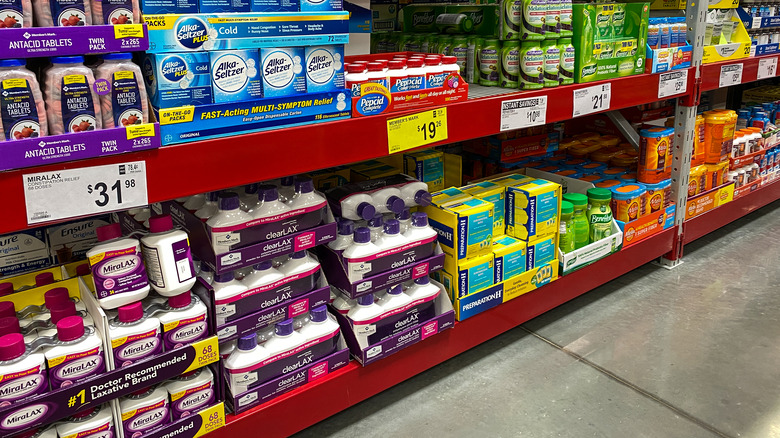MiraLAX Explained: Usage, Dosage, And Side Effects
Constipation is awkward to talk about, but even more awkward to live with. If you experience it, you know it probably won't kill you, but you'll certainly want to get it over with as quickly, safely, and comfortably as possible. And since it was approved for over-the-counter use by the FDA in 2006 (per ABC 7), MiraLAX — a brand of laxative featuring the active ingredient polyethylene glycol 3350 — has become a popular option for those seeking relief from constipation.
Indeed, in the years after its introduction, MiraLAX became so trusted by consumers and doctors that both began administering it for off-label purposes for which it had not been studied or tested, such as treating chronic constipation in children, according to The New York Times. This widespread off-label usage, along with reports of MiraLAX's dangerous side effects in some children, made the medication the center of controversy. But after subsequent study (per the University of Rochester Medical Center), the controversy and concerns about its risks seem to have subsided, and MiraLAX continues to be a popular option for those dealing with occasional constipation. Here's what you need to know about MiraLAX and how it works.
Here's how MiraLAX works
A trip to the laxative section at your local pharmacy will reveal an overwhelming variety of options. According to the University of North Carolina Center for Functional GI and Motility Disorders, this is because not all forms of constipation have the same root causes, so different laxative types may be better suited for some cases than others. Fiber supplements such as Metamucil, for example, are a long-term solution for preventing constipation by changing the texture of stools so they pass more easily from the body. Lubricant laxatives (such as mineral oil) do just as their name suggests — they literally grease the digestive tract to allow stools to slip easily through. In contrast, stimulant laxatives (such as Dulcolax or Ex-Lax) facilitate bowel movements by increasing muscle contractions in the intestines (per the Mayo Clinic).
MiraLAX falls into a fourth category. It's an osmotic laxative and works by drawing water into stools, making them softer and easier to pass — a boon for those with hemorrhoids or other conditions that make it difficult or painful to pass hard stools. As the Mayo Clinic notes, such laxatives don't actually cause bowel movements, but make it easier and more comfortable to pass them.
MiraLAX should not be your first choice for constipation
While most over-the-counter laxatives and safe and effective when taken properly, overusing them — or using stronger laxatives than you need — can make your problems even worse, according to Harvard Health Publishing. Using strong laxatives over a prolonged period of time, for example, can cause your body to become so dependent on them you won't be able to pass a bowel movement without them — not a good situation.
Instead, Harvard Health Publishing recommends you start with the gentlest, most conservative laxative option: bulk-forming fiber-based products such as Metamucil. While these are safe enough to take daily, they need some time to take effect — up to three days for some people. If this doesn't offer the relief you want, try mineral oil or a stool softener such as Correctol (one or the other, not both at the same time). And only if you're still not seeing any effects with these should you move on to trying osmotic laxatives such as MiraLAX. If your condition persists despite trying a number of different medications, it's time to see your doctor.
Here's how you should take Miralax
One reason for the popularity of MiraLAX is that it's easy to take. It comes as a flavorless powder that is intended to be dissolved in water or another beverage before being consumed (per AARP). It's also easy to get the dose right — according to Michigan Medicine, the bottlecap comes marked with a fill line corresponding to the standard adult dose (17 grams). Once you've poured out the right amount, mix it with eight ounces of water or another beverage such as juice, coffee, tea, or soda. Michigan Medicine also suggests adding it to a smoothie with yogurt and fruit. If you're over 65 or have liver or kidney conditions, however, Michigan Medicine recommends only taking MiraLAX with water.
For most occasional cases of constipation, one dose a day is appropriate. There are few other restrictions on exactly how to take MiraLAX. You can take it on a full or empty stomach, and according to the manufacturer's webpage, it can be taken at any time of day. However, Michigan Medicine warns against taking any other medications at the same time as MiraLAX, as they won't be digested and absorbed as effectively as they are intended to be.
MiraLAX was thought to cause neurological problems in children
For a while, MiraLAX was making headlines for all the wrong reasons. As its popularity as an over-the-counter laxative grew, so did its off-label use as a treatment for children with constipation. At the time, as ABC 7 notes, the FDA had only authorized MiraLAX for adult use. Despite this restriction, however, it became a go-to solution for both parents and doctors trying to treat constipation in children. This unauthorized use of the medication was so common that a 2006 study found that in a nationwide sample of 350 pediatricians, 75% had recommended MiraLAX for constipation in children, according to The New York Times.
But some parents, however, noted some disturbing changes in their children's behavior after giving them MiraLAX. Normally cheerful children suddenly became paranoid, angry, and erratic after taking MiraLAX, per ABC 7. Terrified parents demanded the FDA take action, and in response, the FDA launched a study to investigate the effects of the active ingredients in MiraLAX on children. Preliminary findings revealed no meaningful connection between MiraLAX and behavioral or neurological changes, according to the University of Rochester Medical Center, and doctors continued to recommend MiraLAX for pediatric patients.
MiraLAX is now regularly recommended for children's use
Parents concerned about the behavioral changes they saw in their children after giving them MiraLAX hoped that an FDA investigation into the drug's effects on children would confirm their suspicions and put an end to the drug's pediatric use, according to ABC 7. But instead, the FDA study's preliminary results had the exact opposite effect, confirming MiraLAX's efficacy and safety for children, per the University of Rochester Medical Center. While the study found some incidences of mild side effects in children, overall, it found that the benefits of MiraLAX as a treatment for child constipation outweighed its risks.
Since then, MiraLAX has become a standard treatment for chronic constipation in children. UCSF Pediatric Urology, for instance, as a default uses lubricants and osmotic laxatives such as MiraLAX when treating children with chronic constipation, stating that these medications are not only effective, but are safer than other options since they are less likely to be absorbed by the body.
Taken in low doses, MiraLAX can help maintain regularity
MiraLAX was originally marketed as a treatment for occasional constipation in adults, something that's safe and easy to take on those rare occasions your system is feeling a bit out of balance. Since then, doctors have administered it in a number of other ways, with the size and frequency of the dose varying with the patient and the targeted outcome. For instance, small doses of MiraLAX are often used to help develop and maintain regularity in children with chronic constipation problems, according to UCSF Pediatric Urology.
In these cases, MiraLAX serves not only to ensure the child being treated has regular bowel movements, but helps retrain the child's body to stay regular on its own. In chronically constipated children, the rectum stretches to accommodate accumulated stools, causing affected children to lose their ability to sense when their bowels are full. Regular doses of MiraLAX help keep the bowels relatively empty so the child's system relearns to recognize when they are full and need to be emptied. As the child starts to become more regular, doses of MiraLAX can be gradually decreased. Children will typically require maintenance doses of MiraLAX for one to three months.
Higher doses of MiraLAX are used for colonoscopy prep
While MiraLAX is most commonly taken for mild or occasional cases of constipation, it has also been proven effective in cases when more drastic action is needed. One such case is colonoscopy prep: In order for your doctor to get a clear view of your colon during a colonoscopy, your bowels need to be completely empty and clean, with no fecal residue (per the Cleveland Clinic). Thus, cleansing your bowels before a colonoscopy requires some serious laxatives. And many hospitals instruct their patients to use MiraLAX mixed with Gatorade for their prep.
As you might imagine, the standard 17-gram dose in a cup of water won't be enough to do this job. Instead, your cleanse will involve consuming an entire 228-gram bottle of MiraLAX dissolved in 64 ounces of Gatorade over the course of several hours the day before your colonoscopy. Yes, you'll need to stay close to your bathroom and will likely be thoroughly tired of Gatorade by the end of the day. But the good news is that most people only need a colonoscopy once every 10 years, according to Harvard Health Publishing.
If you take certain drugs, check with your doctor before taking MiraLAX
While medications can be beneficial when used correctly for their intended purpose, not all medications play well with each other. As the Mayo Clinic explains, some drugs interact in harmful ways with other medications, causing unpleasant or unsafe side effects or negating the effectiveness of one or both medications. This is why your doctor will ask about any medications you're currently taking before prescribing a new one.
Luckily, MiraLAX has been found to interact negatively with only a handful of other medications, all of which are stimulant laxatives — bisacodyl, licorice, senna, and sodium picosulfate. And as noted by Harvard Health Publishing, it's generally not wise to self-medicate with more than one type of laxative at a time in any case (although for certain procedures, such as colonoscopy prep, more than one type may be recommended, per the Cleveland Clinic). In addition, Michigan Medicine advises against taking other medications at the same time that you take MiraLAX, since MiraLAX may keep them from being properly absorbed by your body.
You may experience these side effects with MiraLAX
Even the mildest medications can trigger side effects in some people, and over-the-counter laxatives are no exception. For instance, fiber-based laxatives, which are primarily composed of plant fiber (per Cornell Health) are known to cause flatulence and bloating in some who use them (per Harvard Health Publishing), and can cause intestinal problems if overused.
While MiraLAX has been shown to be safe and effective for most who use it, it too can trigger side effects. Per Michigan Medicine, some mild side effects you might experience that will typically resolve themselves on their own include bloating, abdominal cramps, nausea, and gassiness. These issues will not require medical attention unless they persist or get worse over time. However, more severe side effects are also possible, including diarrhea, vomiting, rashes, hives, difficulty breathing, and severe bloating or swelling of the stomach. If you experience any of these, seek medical help immediately.
Should you take MiraLAX during pregnancy?
Pregnancy can be a joyous time of one's life, but it can also be uncomfortable at times. And part of the price you may have to pay to bring your little bundle of joy into the world is constipation: Hormonal changes, the growing fetus pressing against your bowels, and even the iron in your prenatal vitamins can all contribute to the problem, according to the Cleveland Clinic. And while you may be desperate for relief, you may also be understandably concerned about your baby's safety. Would the laxatives you normally take, such as MiraLAX, be safe to take now?
Fortunately, the answer is yes: According to the University of California Irvine School of Pharmacy and Pharmaceutical Sciences, the American Gastroenterological Association has determined that MiraLAX is safe for use during pregnancy. Still, the Cleveland Clinic reminds us that the best and safest way to address pregnancy-related constipation is not to get constipated in the first place. They recommend proactively taking preventative measures — such as drinking plenty of water and adding fiber to your diet — to keep yourself regular during pregnancy.
Here's what to expect after taking MiraLAX
As noted by The New York Times, MiraLAX has become the laxative of choice is many households, since the tasteless, odorless powder is easy to take: Simply dissolve it into the beverage of your choice. And while some people can experience mild side effects including bloating and cramps (per Michigan Medicine), they may find the benefits of MiraLAX outweigh the temporary discomfort of these effects. (Those who experience the drug's more severe side effects, such as shortness of breath and vomiting, should obviously stop taking it and seek medical help.)
But while MiraLAX is effective for most who take it, don't expect it to instantaneously cure your constipation. As noted by Harvard Health Publishing, MiraLAX works by drawing water into the stools, making them softer and easier to pass. This means it needs time to work its way through your system and begin to take effect. Thus, according to Michigan Medicine, you should be patient and expect to see improvement in three to five days.












